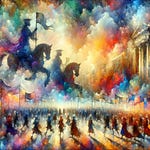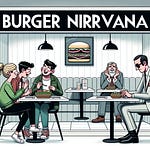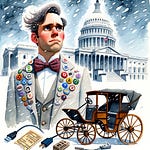Canton 1: The Spectrum Unfurls
In the heart of a bustling metropolis, where skyscrapers pierced the heavens, and the hum of the city was its constant lullaby, there fluttered a flag, not of a nation, but of a people. This was The Spectrum, a grandiose tapestry, each color a testament to a societal group, a microcosm of the city's vibrant diversity. Yet, amid the rainbow of hues, a new color sparked controversy - Azurean, a shade so elusive only a chosen few claimed to see it.
The introduction of Azurean to The Spectrum was met with a whirlwind of reactions. Some hailed it as a progressive step, a celebration of unseen minorities, while others scoffed, deeming it an absurdity, a color for the deluded. In cafes and street corners, in the hallowed halls of academia, and in the echo chambers of social media, the city buzzed with the question: Should Azurean be part of The Spectrum?
The Hue Council, guardians of The Spectrum, found themselves at the center of this maelstrom. They were the arbiters of color, the deciders of what shades represented power, prestige, and identity. And among them sat Ivory, a recent addition representing a newer color on the flag. Though now accepted, her color still lingered in the shadows of the more established hues, a testament to the ever-shifting sands of power within the council.
As Ivory navigated the corridors of power, her eyes, a kaleidoscope of the city's hues, reflected a world where colors were more than mere shades - they were symbols of belonging, of authority, and, in the case of Azurean, a battleground for the very soul of The Spectrum.
Canton 2: Whispers in the Council Chamber
Ivory, draped in her subtly shimmering color, entered the Council Chamber, where the air was thick with the fragrance of power and the murmur of clandestine theories. Here, beneath the grand dome painted with a fresco of The Spectrum, sat the Hue Council, each member a bastion of their respective color.
The council's sessions were often a spectacle of wit and wisdom, a battleground of words. As the debate about Azurean commenced, Councilor Vermilion, a veteran of many color wars, leaned forward, his voice a mix of honey and vinegar. "Azurean, a color for the seers, or a clever ruse by those unnamed to distract us from the true colors of power?"
The chamber erupted in a symphony of retorts and chuckles. Councilor Indigo, always the philosopher, stroked his beard thoughtfully. "But isn't the idea of seeing what others cannot the cornerstone of our Spectrum? Azurean challenges the very perception of reality. Isn't that, after all, what we stand for?"
Ivory listened intently, her mind racing. The insinuation that Azurean was a ploy by the unnamed – those whom the Spectrum was meant to counterbalance – was a theory whispered in hushed tones yet never openly discussed. The irony was not lost on her; the flag that symbolized defiance could, in itself, be a tool of manipulation.
As the councilors bantered, their dialogues a chess game of intellect and ideology, Ivory pondered the more profound implications. Azurean, real or imagined, had become a symbol of division, a paradox within the Spectrum itself. In the quest for inclusivity, had they ventured too far into the abstract, leaving behind the very people they sought to empower?
Councilor Cerulean, known for his pragmatic approach, raised an eyebrow. "Let's not forget, the Spectrum represents all, even those who see or do not see Azurean. Our is to balance representation with reality."
The meeting adjourned without resolution, the air still buzzing with theories and jests. Ivory left the chamber, her thoughts a whirlwind. Azurean, a color invisible to most, had become the most visible divide, a mirror reflecting the complexities of their society.
Canton 3: Colors of Contention
As days turned to weeks, the city's obsession with Azurean grew, its presence (or absence) coloring conversations in every nook and corner. Ivory, ever the observer, found herself in the heart of these dialogues, her own color a footnote in the grander narrative of Azurean.
The debates raged on in the quaint café near the council building, where intellectuals and dreamers mingled. A young artist, her hair a rebellion of colors, proclaimed, "Azurean is the future! It's the evolution of our Spectrum, a step beyond the visible!"
An elderly historian's eyes reflecting the wisdom of eras past countered, "But what of our roots? The Spectrum was to represent the tangible, the real struggles. Azurean muddies the waters, turning our flag into a fantasy."
Ivory, sipping her tea, absorbed these exchanges. The artist's fervor and the historian's skepticism were echoes of the council's divisions. She wondered if Azurean was a symbol of progress or a distraction from the issues plaguing their society?
Later, in the bustling marketplace, Ivory overheard a group of teenagers laughing about Azurean. "Can you see it? Nah, but who cares? It's all a game of who's more unique, more oppressed," jested one, his laughter masking a hint of cynicism.
That evening, under the amber glow of the city lights, Ivory pondered the day's events. Azurean, once a mere color, had become a metaphor for the city's identity crisis. In their quest for inclusivity, had they instead fostered a culture of division and one-upmanship?
The council's next session loomed, and with it, the burden of decision. Ivory knew that whatever the outcome, the ripples would be felt throughout the city. The Spectrum, once a symbol of unity, now reflected a kaleidoscope of conflicts, each color vying for its place under the sun.
Canton 4: The Spectrum's Reflection
The day of the council's decisive session arrived, a day that promised to etch its mark in the annals of the city's history. The chamber was a crucible of anticipation, each councilor carrying the weight of their color, community, and beliefs.
Ivory, her presence now more than just a footnote, felt the gravity of the moment. The debate over Azurean had transcended beyond mere color; it was about the essence of The Spectrum itself. What did it represent? Who did it include? And at what point did inclusion become an abstraction, a departure from reality?
Councilor Maroon, often the voice of reason, addressed the chamber, "We stand at a crossroads. Azurean has stirred our city and challenged our perceptions. But let us not forget that The Spectrum is not just a flag but a symbol of our collective identity. Our decision today will define us, for better or worse."
The debate that followed was a tempest of eloquence and emotion. Arguments were made, philosophies clashed, and Ivory found herself torn. Each word spoken in that chamber was a brushstroke on the canvas of their society, painting a picture of a future yet uncertain.
As the hour grew late, the council reached its decision. Azurean would be part of The Spectrum but not as a standalone color. Instead, it would be a hue visible only under certain lights, a metaphor for the unseen, the unspoken, the unrecognized. It was a compromise, a reflection of the complexity of their society.
Ivory left the chamber with mixed feelings. The decision was made, yet the debate was far from over. Now, with Azurean, the Spectrum was both a beacon of progress and a mirror of societal fractures. The city would continue to debate, to evolve, to question.
The story of The Spectrum and Azurean, as observed by Ivory, was a tapestry of colors, each thread intertwined with the next, creating a pattern of endless possibilities. Ultimately, Azurean was more than a color; it was a question, a conversation, a reflection of a society in constant flux.
Canton 5: The Shades of Change
In the aftermath of the council's decision, The Spectrum, now inclusive of Azurean, fluttered above the city – a symbol of change, yet a canvas of ongoing discontent. Ivory witnessed the city's transformation, struggles, and triumphs as a councilor and citizen.
The inclusion of Azurean sparked a new movement within the city. Inspired by the council's decision, young activists began campaigns for more unseen colors and more unrepresented voices. "The Spectrum is incomplete," they argued, "until every unseen shade is recognized." While noble in its intent, this movement opened a Pandora's box of challenges, each new color bringing its own set of complexities and contentions.
Meanwhile, a counter-movement emerged, advocating for a return to the original Spectrum. "In our quest for inclusivity, we've lost sight of our roots," they claimed. "The Spectrum was meant to unify, not divide." This group, consisting of traditionalists and skeptics, saw the ever-expanding Spectrum as a departure from its original purpose.
Ivory found herself at the center of these conflicting ideologies. Her role on the council and connection to one of the newer colors gave her a unique perspective. She saw the merit in both arguments - the need for inclusivity and the importance of preserving the Spectrum's original intent.
Amidst these societal shifts, a renowned philosopher visited the city, igniting further debate with a provocative question: "Is The Spectrum a reflection of our society, or is our society a reflection of The Spectrum?" This question resonated with many, including Ivory, who began to see The Spectrum not just as a flag but as a metaphor for the city's evolving identity.
Canton 6: Echoes of Azurean
As seasons changed, so did the city's relationship with The Spectrum. The decision to include Azurean, once a contentious issue, had now become a part of the city's fabric, but not without leaving its indelible mark.
Ivory, whose color had slowly gained more acceptance, observed a curious phenomenon. The fervor around Azurean had sparked an artistic renaissance in the city. Artists, musicians, and writers began using The Spectrum as a muse, creating works that explored the themes of visibility, identity, and change. Azurean, in particular, became a symbol of the unseen, inspiring art that played with light and perception.
However, this artistic exploration was not without its critics. A group of purists argued that this new wave of art diluted the true meaning of The Spectrum, turning it into a commercial gimmick rather than a symbol of societal struggle. Debates raged in galleries and theaters, on social media platforms, and in the columns of newspapers.
Amidst this cultural upheaval, Ivory encountered a group of scientists who had begun a project to scientifically analyze The Spectrum. Their goal was to understand how different colors affected societal behavior and perceptions. While grounded in science, this project opened up new philosophical questions about the nature of perception and reality.
Once unified under The Spectrum, the city now found itself navigating a complex web of interpretations and meanings. The Spectrum had become a mirror, reflecting the city's diverse perspectives and experiences. It was no longer just a flag but a living, breathing entity, constantly reshaped by the people it represented.
Reflecting on these developments, Ivory realized that The Spectrum's true power lay in its ability to evoke conversation, challenge perceptions, and reflect society's ever-changing nature. Azurean, once a mere color, had become a catalyst for change, a symbol of the city's unending journey toward understanding itself.
Escutcheon: A New Horizon
The city, now a tapestry of colors and debates, continued to evolve under the ever-changing hues of The Spectrum. Once an observer, Ivory had become an integral part of this narrative, her color a testament to the city's journey towards inclusivity and understanding.
As she walked through the city one evening, the streets alive with the vibrancy of The Spectrum, she overheard a conversation that stopped her in her tracks. Full of curiosity and wonder, a young voice spoke out amidst a group of onlookers gazing up at the fluttering flag.
"Maybe we can add symbols too," the voice suggested, innocently yet provocatively. The idea, simple in its utterance, rippled through the crowd. Symbols, unlike colors, could represent ideas, beliefs, and experiences beyond the visual spectrum. The notion was revolutionary yet daunting in its implications.
Ivory turned towards the voice, her eyes reflecting the myriad colors of The Spectrum. At that moment, she realized that the journey of The Spectrum was far from over. The addition of symbols could open a new chapter in the city's narrative, redefining their collective identity once again.
The End
Do you like what you read but aren’t yet ready or able to get a paid subscription? Then consider a one-time tip at:
https://www.venmo.com/u/TheCogitatingCeviche
Ko-fi.com/thecogitatingceviche
















Share this post